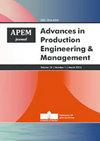求助PDF
{"title":"超载条件下离心泵蜗壳舌部空化的计算分析","authors":"Q. Hu, Y. Yang, W. Cao","doi":"10.14743/apem2020.3.366","DOIUrl":null,"url":null,"abstract":"Volute pump is the most common used centrifugal pump. As cavitation highly contributes to deteriorating the performance of the pump, anti‐cavitation performance is one of its design specifications. To clarify the cavitation evolu‐ tion at the tongue of the volute of a centrifugal pump at overload conditions and its influence on the flow field in the impeller, numerical simulation with ANSYS CFD and a hydraulic test were conducted on a volute pump at several flow rates above optimal value. The cavity distribution and the blade loading distribution were analyzed. And the characteristics of the pressure fluctuation of the monitoring points located in volute casing were obtained and compared with each other. Results showed that cavitation may first emerge at the tongue rather than the impeller inlet at overload conditions. The alternative stress resulting from periodical radial force increases obviously as the extent of cavitation at the tongue. Meanwhile, the mean cavity length grows as each blade comes close to the tongue, and causes a decrease in performance be‐ cause of a reduction or closure of flow passages. The pressure pulsation in the volute is consistent with the blade passing frequency whether cavitation occurs or not, while the pulsation intensity increases obviously after cavita‐ tion inception. From the first section to the eighth section of volute, the pulsa‐ tion intensity of impeller outlet decreases gradually. The results are then compared to provide a reference for the optimum design of the anti‐cavitation performance of centrifugal pump. © 2020 CPE, University of Maribor. All rights reserved.","PeriodicalId":48763,"journal":{"name":"Advances in Production Engineering & Management","volume":"7 1","pages":"295-306"},"PeriodicalIF":2.8000,"publicationDate":"2020-09-27","publicationTypes":"Journal Article","fieldsOfStudy":null,"isOpenAccess":false,"openAccessPdf":"","citationCount":"6","resultStr":"{\"title\":\"Computational analysis of cavitation at the tongue of the volute of a centrifugal pump at overload conditions\",\"authors\":\"Q. Hu, Y. Yang, W. Cao\",\"doi\":\"10.14743/apem2020.3.366\",\"DOIUrl\":null,\"url\":null,\"abstract\":\"Volute pump is the most common used centrifugal pump. As cavitation highly contributes to deteriorating the performance of the pump, anti‐cavitation performance is one of its design specifications. To clarify the cavitation evolu‐ tion at the tongue of the volute of a centrifugal pump at overload conditions and its influence on the flow field in the impeller, numerical simulation with ANSYS CFD and a hydraulic test were conducted on a volute pump at several flow rates above optimal value. The cavity distribution and the blade loading distribution were analyzed. And the characteristics of the pressure fluctuation of the monitoring points located in volute casing were obtained and compared with each other. Results showed that cavitation may first emerge at the tongue rather than the impeller inlet at overload conditions. The alternative stress resulting from periodical radial force increases obviously as the extent of cavitation at the tongue. Meanwhile, the mean cavity length grows as each blade comes close to the tongue, and causes a decrease in performance be‐ cause of a reduction or closure of flow passages. The pressure pulsation in the volute is consistent with the blade passing frequency whether cavitation occurs or not, while the pulsation intensity increases obviously after cavita‐ tion inception. From the first section to the eighth section of volute, the pulsa‐ tion intensity of impeller outlet decreases gradually. The results are then compared to provide a reference for the optimum design of the anti‐cavitation performance of centrifugal pump. © 2020 CPE, University of Maribor. All rights reserved.\",\"PeriodicalId\":48763,\"journal\":{\"name\":\"Advances in Production Engineering & Management\",\"volume\":\"7 1\",\"pages\":\"295-306\"},\"PeriodicalIF\":2.8000,\"publicationDate\":\"2020-09-27\",\"publicationTypes\":\"Journal Article\",\"fieldsOfStudy\":null,\"isOpenAccess\":false,\"openAccessPdf\":\"\",\"citationCount\":\"6\",\"resultStr\":null,\"platform\":\"Semanticscholar\",\"paperid\":null,\"PeriodicalName\":\"Advances in Production Engineering & Management\",\"FirstCategoryId\":\"5\",\"ListUrlMain\":\"https://doi.org/10.14743/apem2020.3.366\",\"RegionNum\":3,\"RegionCategory\":\"工程技术\",\"ArticlePicture\":[],\"TitleCN\":null,\"AbstractTextCN\":null,\"PMCID\":null,\"EPubDate\":\"\",\"PubModel\":\"\",\"JCR\":\"Q2\",\"JCRName\":\"ENGINEERING, MANUFACTURING\",\"Score\":null,\"Total\":0}","platform":"Semanticscholar","paperid":null,"PeriodicalName":"Advances in Production Engineering & Management","FirstCategoryId":"5","ListUrlMain":"https://doi.org/10.14743/apem2020.3.366","RegionNum":3,"RegionCategory":"工程技术","ArticlePicture":[],"TitleCN":null,"AbstractTextCN":null,"PMCID":null,"EPubDate":"","PubModel":"","JCR":"Q2","JCRName":"ENGINEERING, MANUFACTURING","Score":null,"Total":0}
引用次数: 6
引用
批量引用
Computational analysis of cavitation at the tongue of the volute of a centrifugal pump at overload conditions
Volute pump is the most common used centrifugal pump. As cavitation highly contributes to deteriorating the performance of the pump, anti‐cavitation performance is one of its design specifications. To clarify the cavitation evolu‐ tion at the tongue of the volute of a centrifugal pump at overload conditions and its influence on the flow field in the impeller, numerical simulation with ANSYS CFD and a hydraulic test were conducted on a volute pump at several flow rates above optimal value. The cavity distribution and the blade loading distribution were analyzed. And the characteristics of the pressure fluctuation of the monitoring points located in volute casing were obtained and compared with each other. Results showed that cavitation may first emerge at the tongue rather than the impeller inlet at overload conditions. The alternative stress resulting from periodical radial force increases obviously as the extent of cavitation at the tongue. Meanwhile, the mean cavity length grows as each blade comes close to the tongue, and causes a decrease in performance be‐ cause of a reduction or closure of flow passages. The pressure pulsation in the volute is consistent with the blade passing frequency whether cavitation occurs or not, while the pulsation intensity increases obviously after cavita‐ tion inception. From the first section to the eighth section of volute, the pulsa‐ tion intensity of impeller outlet decreases gradually. The results are then compared to provide a reference for the optimum design of the anti‐cavitation performance of centrifugal pump. © 2020 CPE, University of Maribor. All rights reserved.


